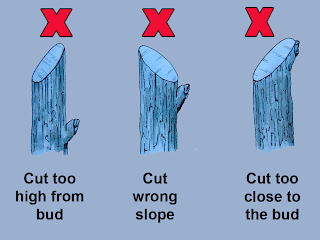Buy the best tools you can afford for they not only do the job well but will last you a lifetime if care for properly. Pruning tools should always be sharp when pruning so clean cuts can be made. Cuts that result in bark tears, stubs, and a jagged surface are slow to heal, or they may not completely heal over.
1. Hand shears, Secateurs or By-Pass Pruners.
They are called by many names - hand shears, secateurs or by-pass pruners. This is the most common pruning tool used by farmers. There are two styles of hand shears: scissor/hook-and-blade and anvil.
A scissor or hook-and-blade shears
Scissor, or hook-and-blade, shears are considered by many to be the best. They make cleanest, closest cut. A scissors type of hand shear is used to prune small size wood up to 1/4 inch diameter.
An anvil shears
Anvil shears have a straight-edged blade that cuts against a soft metal anvil. They are lighter than other shears, but cannot cut as closely or as cleanly. They can crush the stem as they cut it.
Do not cut stems more than 3/4-inch in diameter (about pencil thickness) with hand shears.
2. Loppers.
 Long handled loppers are used for cuts about 1/4 to 1/2 inch in diameter and are usually needed by the third year of tree growth.
Long handled loppers are used for cuts about 1/4 to 1/2 inch in diameter and are usually needed by the third year of tree growth.Loppers require two hands to use, bring additional leverage to bear, allowing you to cut branches up to 3 inches in diameter.
Loppers also come in hook-and-blade and anvil styles.
Loppers are useful for pruning hard-to-reach or thorny growth.
 3. Fine-toothed pruning saw
3. Fine-toothed pruning sawA saw will be needed for branches larger than 1/2 inch or cuts where pruning shears and loppers cannot reach. For branches greater than an inch in diameter, use a pruning saw, not a carpenter’s saw.
Pruning saws have curved blades designed to cut on the pull stroke. Saws, with razor-tooth teeth, cut larger limbs quickly. Bow saws are lightweight and make quick work of medium-size branches.
4. Ladder.
A tall ladder is necessary as the tree grows bigger
Avoid standing on tree limbs since it may damage the bark.
5. Pole pruner and/or pole saw.
 Long-handled equipment is used to make cuts in high areas while standing on the ground. Pole pruners are handy for high work, especially in places where using ladder would be dangerous. Do not cut dead wood more than 1-inch in diameter with a pole pruner.
Long-handled equipment is used to make cuts in high areas while standing on the ground. Pole pruners are handy for high work, especially in places where using ladder would be dangerous. Do not cut dead wood more than 1-inch in diameter with a pole pruner.Pole pruner and pole saw
6. Pruning Knife
A pruning knife is very useful to trim off snags or tears.
How To Prune
Select the proper tool, depending on the thickness of branches to cut. The diameter of branches pruned with shears and loppers should not be large since the jaws may be sprung or lopper handles broken.
Cutting blade held close to remaining branch for a smooth cut
Left - correct way to cut; Right - wrong way to cut
As a cut is made, place the cutting blade of the shears or loppers close to the remaining branch. This will result in a smooth cut without leaving a stub.
Larger branches should be removed in two steps to prevent tearing the bark.
- At a point about 6 to 12 inches from the point of attachment, cut on the bottom of the branch to be removed; then cut through from the top.
- Remove the remaining stub with a cut even with remaining supporting branch.
How To Saw Off A Large Branch
You should only saw off large branches that are not higher than your shoulder. Any work that requires a ladder will need another person to help you.
- Make the first cut beneath the branch, the undercut, about 30cm from the trunk.
- Make the second cut, the top cut, 5cm beyond the undercut, cutting squarely until the branch falls away.
- Make the third cut, the final cut, just beyond the branch collar.
3 steps to saw off a large branch
Good and Bad Cuts
Bad cuts
Bad cuts and good cut
The cut on the left is a good cut. The others are examples of bad cuts.
1. Good cut; 2. Bad cuts














